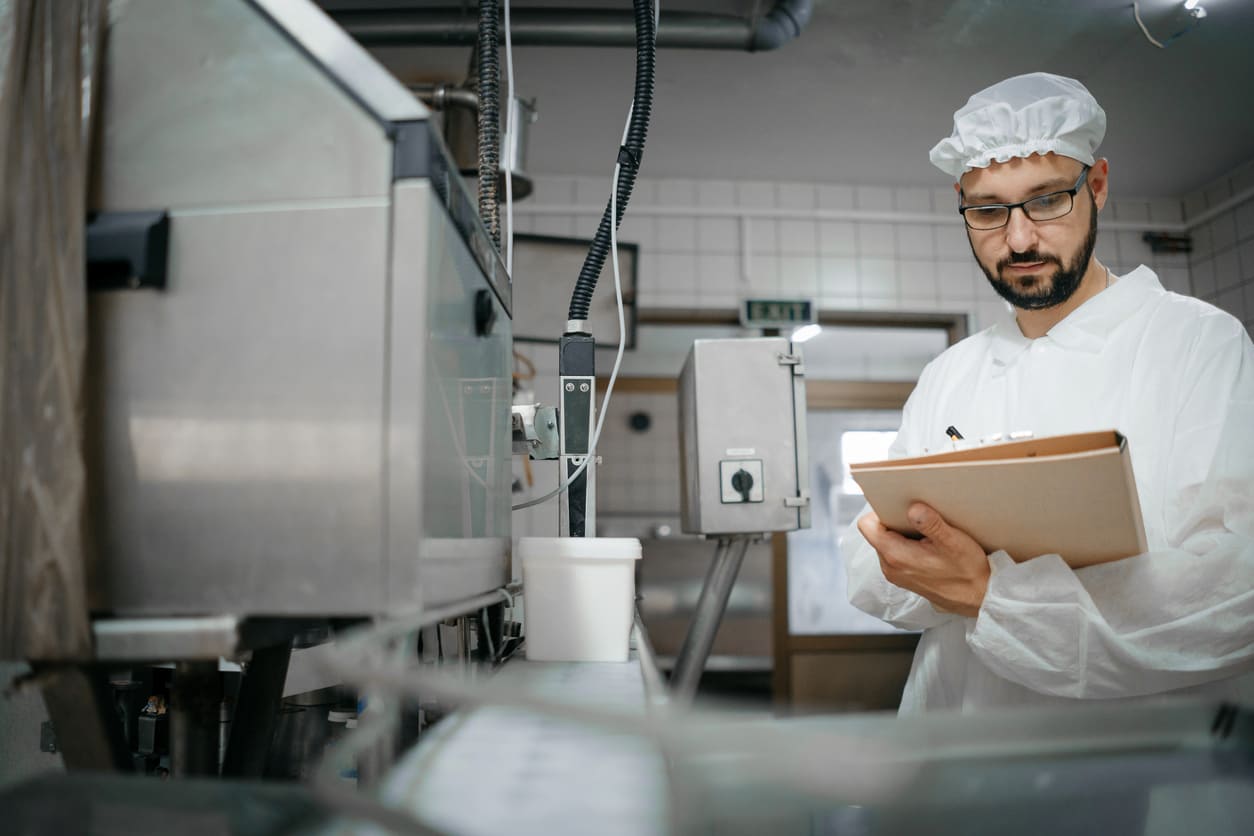Established as a framework for food producers and manufacturers, the Food Safety Modernization Act (FSMA) serves to prevent contamination of raw materials during processing and in the finished product.
Whether you are a farmer, manufacturer, a supplier, or sit somewhere else in the food supply chain, it’s critical to understand what you need to do to maintain FSMA compliance.
One of the principal challenges companies encounter when diving into FSMA regulation is understanding the law and the rules and programs it sets forth. Identifying where each rule fits, and how they apply to food facilities and operations can be overwhelming at first.
We understand how frustrating navigating the complexities of the regulatory landscape can be. That’s why we’ve made this guide to help you master FDA compliance.
Jump to the FSMA Rule that interests you most:
- Preventive Controls for Human & Animal Food
- Food Traceability
- Intentional Adulteration
- Sanitary Transportation
- Produce Safety
- Accredited Third-Party Certification
- Laboratory Accreditation for Analyses of Foods
- Voluntary Qualified Importer Program
- Foreign Supplier Verification Program
What is FSMA?
The Food Safety Modernization Act is a complete overhaul of the Food Safety System that was designed to strengthen the US Food Safety System and prevent foodborne illness.
Signed into law by President Obama on January 4, 2011, FSMA gives the Food and Drug Administration (FDA) enforcement power over the newly implemented rules and programs.
The Food Safety Modernization Act provides a new approach that shifts the emphasis from responding to food-borne illness events to proactively preventing them at the processing and manufacturing level.
From raw material production and supply to the distribution of finished products and raising animals, FSMA’s rules and programs are based on a farm-to-table concept that assures broad coverage across each business in the process.
These rules and programs build on and complement one another to create a robust and effective Food Safety system that decreases the number of food-borne illnesses and helps protect your business’s reputation.
They ensure a safe food supply for American consumers.
Preventive Controls for Human & Animal Food
The purpose of the Preventive Controls rule is to assure that food is not adulterated under section 402 of the Federal Food, Drug, and Cosmetic Act (FD&C Act) or misbranded under section 403(w) of the FD&C Act.
The application of hazard analysis and risk-based preventive controls enables a proactive food safety system. It helps your facility protect both the food from potential hazards that may cause illness or injury to consumers if present in the food produced.
The Preventive Controls rule has specific requirements including:
- A written food safety plan (FSP)
- A hazard analysis
- Preventive controls
- Monitoring
- Corrective actions
- Verification activities
- A Recall plan
- Maintaining associated records
To meet these requirements, you will first need to designate a Preventive Controls Qualified Individual (PCQI). These individuals are responsible for developing and overseeing the implementation of the FSP, which is a dynamic document that needs to be reanalyzed every 3 years. You will also need to revisit this plan whenever changes in the product or process occur that impacts the food safety plan.
If you have a HACCP plan in place, you must ensure that it complies with the requirements stated in 21 CFR Part 117 for human food or 21 CFR Part 507 for animal food.
Distinctions in Preventive Controls
When it comes to Preventive Controls for Human Food, this rule helps ensure:
- The finished product is protected against biological, chemical, and physical contaminants
- The food is safe for its intended use
- The product is not misbranded regarding labeling for allergens
Regarding Preventive Controls for Animal Food, the rule works to ensure:
- Nutritional requirements for the intended species are met
- Finished products do not contain toxic components and are adequate for ingestion
- Prevention of biological contamination that can result in illness of the animal or the handlers of the food
Food Traceability (FSMA 204)
The Food Traceability rule outlined under FSMA 204 is intended to result in faster identification and removal of potentially contaminated food from the US market. Inconsistent traceability records, or lack thereof, causes delays during outbreak investigations and recall events which can result in more cases of illness or death.
Through this rule, FDA has established record keeping requirements for high-risk foods listed in the Food Traceability List (FTL) and certain activities in the supply chain referred to as Critical Tracking Events (CTEs). This is to ensure that traceability information, referred to as Key Data Elements (KDEs), is kept.
In addition to maintaining KDEs, the rule also requires a written Traceability Plan and the use of traceability lot codes.
It’s also important to note that FDA may make changes to the Food Traceability List at any time. If they remove foods, the removal will be effective immediately. However, if they decide to include new foods, the change will take effect in 2 years, allowing time for industry to prepare.
Critical Tracking Events & Key Data Elements
FDA has identified steps in the supply chain called Critical Tracking Events. These are the instances where traceability records must be kept. CTEs for foods placed on the FTL can include everything from harvesting and cooling to shipping and receiving, among others.
For every CTE, there are specific Key Data Elements that must be kept. General examples of KDEs include anything from business name and contact information to product description and quantity.
Traceability Lot Codes
The Traceability Lot Code is an important KDE that is defined as a descriptor — often alphanumeric — used to help track the food back all the way to its original source.
When initially packing a raw agricultural commodity (RAC), land-based receiving of a food, or transforming a food, this FSMA rule requires the creation of a traceability lot code. Once the TLC has been assigned, it must stay the same unless the food is transformed. Therefore, simply transporting or holding food will not result in changes to the TLC.
Intentional Adulteration
The Intentional Adulteration rule— often referred to as Food Defense — helps with the implementation of mitigation strategies that target the vulnerabilities of specific types of process operations and a facility. This helps prevent individuals or groups of people from intentionally introducing a contaminant into food intended for human consumption, guarding against wide-scale harm to public health, including acts of terrorism.
The Intentional Adulteration rule has outlined specific activities that are required to maintain FSMA compliance. This includes:
- Creating a written food defense plan (FDP)
- Conducting a vulnerability assessment
- Documented mitigation strategies
- Continued monitoring
- A list of corrective actions
- Verification activities
- Maintaining associated training and records
A Food Defense Plan (FDP) has an approach similar to HACCP in conducting the identification and evaluation of significant vulnerabilities, and the actionable process step, where the mitigation strategies will be implemented.
It’s important to note that vulnerability assessments must evaluate the following elements:
- The severity and scale of the potential impact on public health
- The degree of physical access to the product
- The ability to successfully contaminate the product
- The possibility of an inside attack
A Qualified Individual must be designated as the person responsible for developing and supervising the implementation of the FDP. This document needs to be reanalyzed every 3 years. The identified vulnerabilities depend on the assessment conducted by a qualified individual and the efficiency of the mitigation strategies implemented. Companies have the flexibility to identify a mitigation strategy that is appropriate to their process and facility.
Sanitary Transportation
The Sanitary Transportation rule was established as part of the Sanitary Food Transport Act (SFTA) with outlines for its implementation established as part of FSMA. This rule institutes requirements for the shippers, carriers and receivers that transport human and animal foods to implement sanitary practices that help ensure the safety of food products.
General Requirements for Sanitary Transportation
Non-exempt shippers, receivers, loaders, and carriers that transport human and animal food in the United States must adhere to the following requirements:
Vehicles & Transportation Equipment
This regulation requires that transportation equipment be designed in a manner that does not cause the food to be unsanitary and unsafe for consumption.
It also mandates that cleaning and maintenance practices for vehicles and equipment be in place to prevent contamination events.
Transportation Operations
This requirement includes the procedures that should be followed to ensure that the food is transported in sanitary conditions. These operations include procedures to control:
- Transportation conditions (temperature parameters)
- Cross contact prevention regarding allergen presence
- Cross contamination between ready to eat foods and raw foods
- Contamination between food items and non-food items
Training
Carriers and employees must be trained in sanitary transportation practices and maintain documentation that training has taken place.
Records
Records of procedures, training, and agreements must be maintained as evidence of compliance with the regulation.
Produce Safety
This rule was established as part of the FDA Food Safety Modernization Act to establish standards for growing, harvesting, packing, and holding of fruits and vegetables.
The general purpose of produce safety is to reduce microbial contamination to help prevent foodborne illnesses in fresh foods. Produce — vegetables and fruits — can be divided into 2 groups, based on how the rule applies to them.
These groups are covered produce and not covered produce.
Covered produce are fruits and vegetables that are considered raw agricultural commodities. These commodities are foods that will be consumed raw without any other treatment that can eliminate microorganisms. This includes fruits, leafy greens, herbs and nuts. Think of anything that you would eat as a salad or snack or in general any fresh fruit and vegetable that does not require cooking before consumption.
Produce that is not covered by the rule is, in general, not consumed raw. This includes beans, asparagus, potatoes, corn, and other vegetables that need to be cooked before they are consumed.
Standard Requirements for Produce Safety
The Produce Safety Rule has established minimum standard requirements that must be followed by growers to limit the potential for biological contamination from the environment in fresh produce.
They are as follows:
Employee Health & Hygiene
Employees must be trained in topics such as personal hygiene, food safety, work safety, the appropriate processing for packaging, holding, growing and any steps that are taken during the production process to help minimize the potential of contaminating the fruits or vegetables.
Agricultural Water Quality
This regulation states that the water used to irrigate produce must be safe and adequate, meaning that it is free of microorganisms that can cause food-borne illnesses.
Animals
Action must be taken to minimize the presence of domestic or wild animals in the fields to limit the potential of contamination.
Biological Soil Amendments
A soil amendment is defined as a material added to the soil to improve its chemical or physical conditions. Usually, growers use manure or other types of biological matter to mix with their soil.
As this can be a source of microbial contamination for fresh produce, FDA has established specific standards for the use of these types of amendments.
Equipment & Tools
Equipment and tools used during harvesting and packaging should be kept in good condition and follow cleaning and sanitation practices to minimize the potential for contamination events.
Buildings
Structures should be designed in a way that separates raw product from cleaned and processed products as this further limits potential contamination.
Sprouts
Due to how sprouts are grown and harvested they create favorable conditions for pathogens to grow and historically have been linked to many outbreaks and recalls.
This specific section of the produce safety rule was developed to ensure that sprouts are grown, harvested and packaged in conditions that prevent contamination from the environment.
Accredited Third-Party Certification
A voluntary program, Accredited Third-Party Certification was established by FDA to set forth and regulate how FDA will recognize accreditation entities. It also details how those accreditation entities will accredit certification bodies, and how certification entities will conduct food safety audits and issue certifications for individual food facilities.
This rule allows accredited certification bodies to plan and conduct unannounced audits of food facilities. These bodies may also monitor certified facilities in the event of suspected non-compliance and even immediately address deficiencies with corrective actions.
Advantages of an Accredited Third-Party Certificate
Under the Preventive Control and FSVP rules, facilities and importers can choose on-site audits for supplier verification. While not a requirement, having a certificate from an accredited third-party entity can be beneficial in two instances:
- An importer wants to establish themselves within the Voluntary Qualified Importer Program (VQIP). This program requires the importer to collect and maintain accredited third-party certifications for each foreign supplier’s facility.
- FDA may require an imported product to have such a certificate. FDA will base their import certificate decision on the following factors:
- Food safety risks of the food and its origin
- Evidence of an inadequate food safety system
Laboratory Accreditation for Analyses of Foods (LAAF)
Ever since LAAF’s establishment in February 2022, only FDA recognized and accredited laboratories are able to conduct food testing for the various circumstances defined by this rule.
The Laboratory Accreditation for Analyses of Foods Program covers food testing for:
- Removal of a food from an import alert
- Admission of imported foods
- Testing requirements for sprouts, shell eggs, and bottled drinking water
- Directed food laboratory orders
Evidence for mandatory food recalls, suspension of facility registration, or detention appeals
The establishment of the LAAF program empowers FDA’s ability to protect US consumers from potentially unsafe food. It improves the accuracy and reliability of certain food testing through uniform standards and the enhanced oversight of accredited laboratories.
Voluntary Qualified Importer Program (VQIP)
The Voluntary Qualified Importer Program (VQIP) is an optional, fee-based, FSMA program that provides benefits to eligible importers during the entry process to expedite the review and importation of food.
The entry system is designed to recognize and have US Customs immediately release the line entries covered under VQIP after entry documents are submitted. This program only applies to importers and foods for which an application was submitted to FDA and deemed in compliance with the applicable requirements.
To be accepted into the Voluntary Qualified Importer Program, importers must demonstrate a high level of control over the safety and security of their supply chains. Their foreign suppliers must also undergo and pass inspections by a certifying body approved under the FDA’s Third-Party Certification Program.
Foreign Supplier Verification Program (FSVP)
The Foreign Supplier Verification Program (FSVP) rule expands the responsibility of ensuring the safety of imported foods to include US importers. It no longer places that responsibility solely on the foreign manufacturer’s shoulders as with other rules like Preventive Controls and Produce Safety.
Before FDA instituted FSVP, many US importers’ food safety systems included procedures for verifying the safety of their imported food but not all. With the establishment of the FSVP rule, the FDA now has enforcement power to inspect US importers of human and animal food and verify that:
- All food is produced in a manner that meets the same level of public health protection as with established preventive controls for human food or animal food, and/or the produce safety rule, as applicable
- Imported food is not considered adulterated as defined under section 402 (§342) of the Federal Food, Drug, and Cosmetic Act (FD&C Act)
- Food products intended for human consumption are not misbranded concerning food allergen labeling as defined under section 403(w) of the FD&C Act
It’s also important to note that each FSVP implemented is unique to the supplier, the product, the process and the importer. Creating an FSVP also involves various key considerations to assure compliance with the program.
These include everything from where a supplier is based and if FDA recognizes their food safety system, to where in the supply chain hazards are controlled and if the importer is subject to other FDA regulations.
The Foreign Supplier Verification Program has several other key considerations deserving of an importer’s attention. We cover these in detail and the 8 simple steps to assure continued FSVP compliance in our complete guide, FSVP 101: Everything You Need to Know As An FSVP Importer.
How to Simplify FSMA Compliance
The Food Safety Modernization Act is here to help protect consumers from potential hazards and to help track issues throughout the supply chain.
FDA takes compliance with these rules very seriously and missing critical procedures or safety measures required of your business can cause irreparable damage to your reputation and your bottom line.
You can easily achieve full FSMA compliance by leveraging the world’s largest FDA compliance company in the industry. Registrar Corp has spent the last two decades helping over 30,000 companies each year across 180+ countries navigate the complexities of FDA regulations.
We can help you, too.
Discover how you can easily master FSMA with Registrar Corp’s industry leading compliance solutions.








